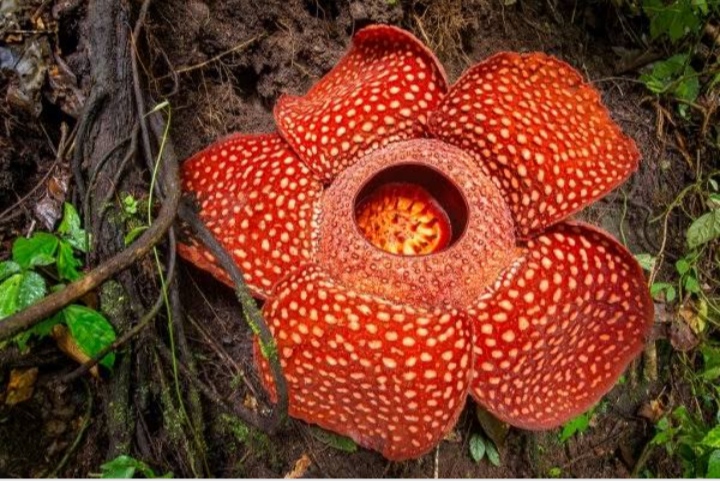The world’s largest flower
Rafflesia arnoldii:
Rafflesia arnoldii, the largest flower in the world belongs to the Plantae kingdom and Rafflesiaceae family. The genus Rafflesia is named after Stamford Raffles who is the founder of British colony in Singapore. Rafflesia is a huge five- petaled individual flower that produces the largest bloom among all other large flowers. The flower attaches itself to a host plant for its water and nutrients requirement. The Rafflesia plant is referred to as “monster flower” as it is a plant with parasitic properties and repugnant stench. It can grow around 3 feet in diameter and weigh upto 10 to 12 kg.
Rafflesia arnoldii is also known as stinking corpse lily for its unpleasant odour. Rafflesia has reddish brown coloured petals along with white freckles that enable it to emit the smell of rotting flesh in order to attract the carrion flies ( the pollinators) in order to pollinate the plant. The flower reeks because of the reddish tentacle that is like branched ramentae inside the corolla petals. The largest bloom is believed to be related to poinsettias, violets, passion flowers and members of Malpighiales.
Rafflesia takes around 9 months to 21months for maturation, then it opens up into a cabbage sized bud. But the flower lasts for only a few days (5-7days). According to scientists the plant has no visible leaves, stems and roots. Rafflesia cannot undergo photosynthesis like any other green plants as it does not have chlorophyll. Its stamens and pistils are fused together in a central column that produces a crown in the shape of a ring. The sexual organs of Rafflesia arnoldii are present beneath the rim of the disk. These are unisexual by nature. Rafflesia fruit can be around 15cm in diameter filled with flesh and tiny hard coated seeds which is a feed to forest animals and tree shrews.
The giant flower is rarely found and is hard to locate. Rafflesia is mostly found in Borneo and Sumatra rainforests in Indonesian Archipelago and also in the rainforests of Malaysia .The enormous bloom is one of the three national flowers of Indonesia , it is the official state flower of Sabah in Malaysia and Surat Thani Province, Thailand. Rafflesia arnoldii is an enormous flower with very unusual characteristics, it grows on the tendrils of the Tetrastigma vine which is related to the genus of grape plant. Tetrastigma provides the food and water for the plant that is essential during its short lived lifespan.
As Rafflesia is one of the rarest plants on the earth and it takes around 9-21 months for budding. So, people tried to artificially cultivate the plant but all the experimental efforts were a failure.
According to CNN Indonesia’s report
Recently bloomed Rafflesia arnoldii in West Sumatran forest was around 4 feet in diameter which was recorded as the largest bloom over all these years. Previously in the year 2017 Rafflesia bloomed in the same rainforest of Sumatra in Indonesia was considered as the largest flower in the world.
By: Aishwarya Shivakumar

